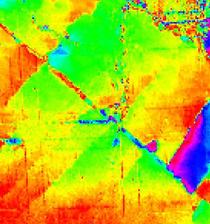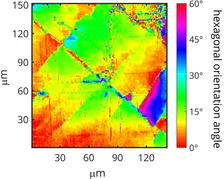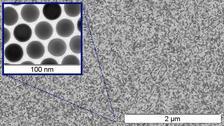Details of the measurements at the PETRA III beamline P10, further information see below (picture: F. Lehmkühler, DESY).
A research team from the Universität Hamburg, DESY, the Cluster of Excellence CUI and the Freie Universität Berlin has found a new way of arranging gold nanoparticles in the form of ordered lattices. These crystalline layers have a wide range of applications, and in the future the new process could be used to manufacture tiny components for nanoelectronics and to customise interactions between light and matter.
Nanoparticles made from precious metals, such as gold or silver, are between few and 100 nanometres in size. They are found in some medieval church windows, for instance, where they are responsible for vibrant colours of the stained glass. These colours are produced by collective oscillations of the free electrons in the metal particles driven by light. The nature of these oscillations and the way they interact in larger ordered structures, so-called superlattices of the metal particles, depends to a large extent on the specific geometry of the array. Scientists are looking to find the particular rules for building such superlattices, because they offer enormous potential for new materials with new emerging electrical, optical and mechanical properties. Being able to control both the structure of the nanoparticle building blocks and the geometry of the superstructure could lead to designer materials that allow to adjust these properties precisely.
The research team has now succeeded in making large single, double and multiple crystalline layers of gold nanoparticles with only a small number of defects. To do so, the scientists synthesised gold nanoparticles of very similar shapes and sizes, and coated them with a polymer. By varying the diameter of the particles, their concentration, the length of the polymer chains and the deposition times, they were able to produce large superlattices with different numbers of layers and separations between the particles, and to examine these using the synchrotron radiation source at DESY. The experiments, carried out at the PETRA III beamline P10, revealed the formation of perfectly ordered domains covering large areas of more than 1000 square micrometres (µm²). “The high-resolution study at PETRA III revealed a previously unknown effect,” explains Felix Lehmkühler, a scientist at DESY. “The spacing between the particles increased with the number of layers.” This will help the scientists to develop a better understanding of how the particles self-assemble into layers. The quality of the gold superlattices that have now been produced will be useful for a wide range of applications, from fundamental studies of the interaction between light and matter, to optical metamaterials and substrates for surface-enhanced spectroscopy.
In the future, the research group hopes to use this technique to produce further lattice structures, also using different materials. So-called binary structures are also conceivable, made up of particles of two different sizes and thereby paving the way for even greater structural diversity. In addition, the team is working on controlling the number of layers in the lattices and achieving very large lattice areas in the range of square centimetres.
(from DESY news)
References:
Structural order in plasmonic superlattices, F. Schulz, O. Pavelka, F. Lehmkühler, F. Westermeier, Y. Okamura, N. S. Mueller, S. Reich, and H. Lange, Nat. Commun. (2020). DOI: 10.1038/s41467-020-17632-4
Plasmonic Supercrystals with a Layered Structure Studied by a Combined TEM‐SAXS‐XCCA Approach, F. Schulz, F. Westermeier, F. Dallari, V. Markmann, H. Lange, G. Grübel, F. Lehmkühler, Adv. Mater. Interfaces, DOI: 10.1002/admi.202000919









